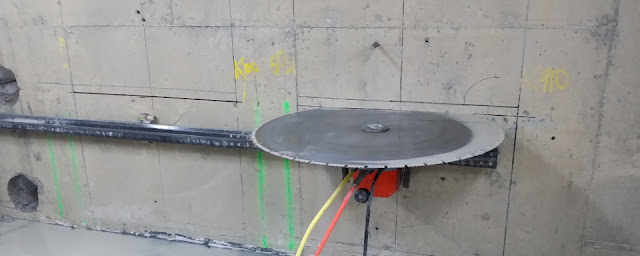A Detailed view of Wall Sawing
If you decide to cut through your walls, you have many options. Wall sawing is the most often used way of cutting concrete. The technique is mostly used to cut holes for new doors, windows, and other structures.
Additionally referred to as concrete track sawing, the wall sawing technique utilises a track-mounted saw to create vertical and horizontal cuts. Diamond wall sawing is the solution if you need to cut through a wall at any angle. All diamond sawing equipment must be operated by an operator that is highly trained and experienced. The entire process must be monitored by an operational engineer to provide a safe working environment.
Ascertain that the diamond blades are in good condition before beginning the concrete cutting procedure. They should not be used if they are broken or missing blade segments. It is critical to pick the appropriate instrument for the job at hand. As previously stated, diamond saw blades must be used in wet circumstances. Avoid using it to cut dry concrete.
The requirement for precise holes in the concrete necessitates the use of strong cutting tools. Electrical or hydraulic power sources are typically utilised as power tools used for concrete sawing. A wall saw is a powerful instrument that should be handled with caution and safety. When cutting, it is critical to consider the blade's size. Experienced operators understand that as the blade is bigger, the saw must be moved carefully. The initial move should not be a bold one. Nowadays, blades come in a variety of shapes and sizes. The size of a diamond blade will vary according to the depth and size of the cuts required. They have a maximum cutting depth of 90mm. Diamond saws are used in demolition projects to remove concrete buildings.
The process of locating a reputable concrete contractor must be taken very seriously. Wall sawing in Sydney is a sensitive process that requires a highly experienced individual to do the work accurately and effectively. Conduct an Internet search for online reviews or solicit suggestions from friends.
Diverse Techniques for Concrete Sawing
The concrete sawing method is an integral element of any building process since it is used to make accurate cuts and holes through any material. You will learn about several different concrete sawing techniques in this post.
At any point throughout the construction process, openings for doors or windows, water lines, and electrical wires may be required. Apart from concrete, this method is effective for cutting through any hard material, including bricks or tiles, masonry, and other hard surfaces. The need for concrete sawing has risen in recent years, owing to the simplicity with which walls, floors, and other surfaces may be cut.
To begin, the concrete sawing process might be either dry or wet. Due to the huge amount of dust generated, dry sawing is employed in big outdoor projects. This method employs a diamond blade that operates without the need for water and protects against overheating. The wet sawing technique is the polar opposite. In this scenario, the blades function with water, which eliminates the presence of dust. Thus, we may conclude that this approach is more environmentally friendly than dry sawing.
The floor sawing technique, as the name implies, is used to make cuts on flat surfaces such as concrete floors, highways, and slabs. There are specialised floor saws that operate on fuel or electricity. They may be used both indoors and outdoors and have a cutting depth of up to 500mm.
The method of wall sawing is used to create holes in vertical surfaces in areas like Sydney. It is the most effective method for cutting your wall to accommodate new doors and windows. Wall saws are the tools used for this sort of cutting.
Wire saws are used for producing various sorts of forms in varying sizes in reinforced concrete. This technique involves the use of wire rope that has been embedded with diamond beads. Not creating fractures around the cutting surface is maybe the biggest feature of this method. Generally used for creating big holes into walls.
For small and medium-sized concrete sawing tasks - the ring saws are suitable. Due to their compact nature, they are often referred to as handheld tools. When workers are confined to a small amount of interior area, they rely on these tools.
Wet or dry sawing, floor or wall sawing, wire or ring sawing - the possibilities are endless and in your hands...
Concrete Cutting Dos
The critical point to remember is, to begin with, a single surface cut. This enables you to spot the place where you are cutting along, while also disrupting the compactness of the concrete which makes it simpler to cut through. Allow it to run freely every 30 seconds for optimal cutting results. This will prevent the saw from overheating. When cutting through concrete, always use appropriate safety equipment. Flying debris is highly dangerous and can result in catastrophic damage. As a result, it is critical to use protective eyewear, earmuffs, and gloves.
Concrete Cutting Don'ts
A cutting tool that is pressed too hard is a major error. Allow the saw's weight to accomplish the cutting as your guide.
Never begin using a saw without first sketching up a plan in your head and on the wall for how the task will be completed. Prepare properly by tracing the area you wish to cut with a piece of chalk.
We like to emphasise that there is no room for error when it comes to wall sawing in areas like Sydney. Are you not thinking the same thing?! It is now your turn.
Disclaimer: This is generic Information & post; content about the services can be changed from time to time as per your requirements and contract. To get the latest and updated information, contact us today or visit our website.




Comments
Post a Comment